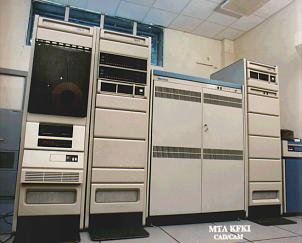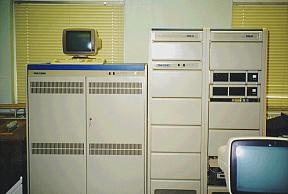"The TPA-11/580 is the fastest and high-performance 32-bit, open architecture member of the KFKI TPA-family. With a microcoded central processing unit, the speed and performance is due to its efficient instruction set and the paralell execution of independent procedures. Its operating system is the VAX/VMS virtual memory management system that can use up to 4 GBs of memory and can work with intrinsically infinte programlengths" (KFKI TPA-11/580 Hardware Handbook)
After producing PDP-11 clones, KFKI decided to build a "clone" of the Digital VAX-11/780. There was great demand on computers of this size and performance, but due to the restrictions of the "western countries", no real VAX was allowed to be shipped to Hungary or to any other country of the "eastern bloc". The VAX had an appeal with its PDP-11 compatibility mode, and it was microcoded, so the main goal was to construct an "iron" that runs the original microcode.
The project started in 1983, and ended in 1987. Cloning the VAX-11/780 was hard, because the development team didn't had a machine to examine, they used what they could get access to, so the process took rather long time.
The main specifications of the TPA-11/580:
- Microcoded 32-bit CPU:
- 16 x 32-bit general purpose register
- 4 CPU operating modes:
- 32-bit, high-speed, asynchronous system bus:
244 native instruction + PDP-11 instructions for compatibility mode
kernel, executive, supervisor, user
SBI (Synchronous Backplane Interconnect)
- The CPU
- The memory
- Adapters of other busses like UNIBUS (UBA), MASSBUS (MBA)
The memory subsystem consists of the memory controller (connected to the SBI) and the storage modules (connected to the controller). The TPA-11/580 could handle two memory controllers, so the maximal memory ammount with the MS580-C controller was 2x4=8 MB. There was another controller, the MS580-F that was to be able to use 64 MB, but I don't know if that was ever manufactured. The subsystems stores everything in 64-bit quadwords with 8 bit of ECC (Error Correcting Code) information attached to each quadword (which gives 72 bits total).
The UBA (Unibus Adapter) connects the main system bus to the asychronous UNIBUS. The adapter has its own arbitration and it also translates the 30-bit SBI addresses to 18-bit UNIBUS addresses, handles DMA and data puffering (The UBA does 4 UNIBUS-cycles on one SBI cycle).
The console system was a qbus machine called TPA-11/110 or TPA-Janus. It was based on the russian MicroPDP-11 compatible Elektronika MC1201.01 card, and contained a 5.25" mini-floppy unit, an EPROM that emulated another floppy and an RX01-compatible floppy disk formatter. This subsystem was able to do everything that an LSI-11-based VAX-console could do, including running diagnostics, doing ODT or bootstrapping the TPA-11/580.
More than 20 TPA-11/580s were sold.
Pictures:
The inside of the processor cabinet (with original
Digital PSU's)
The front switches
The wire-wrapped backplane
KFKI TPA-11/582
There was an asymmetric multi-processor (AsMP) configuration available too, it was called TPA-11/582. When asymmetric multiprocessing was dropped in VMS 5.x, most of these systems were disassembled, but there's one such system still operating, running special software that drives the simulator of the control room in the Nuclear Power Plant of Paks (Hungary)!
The configuration was similar to a normal 11/580, but with one UNIBUS nexus (UBA) replaced with another processor, which used the same memory and clock signals, and was available through interrupt #7. The scheduler of VMS 4.0 was modified to allow this (5.0 would have been too hard to modify, so the highest version of VMS on a TPA11/582 is 4.x).
Another picture:
The same system from a different angle
TPA-11/585
After the 11/582 was ready, the developing team went on and created a faster version of the machine, just like Digital did with the VAX11/785. The upgrade needed about 8 boards to be replaced, some 11/580 systems were upgraded to 585s. Around 6-8 were built.
TPA-11/587
The two-processor version of the 11/585, in the manner of the 11/582.

